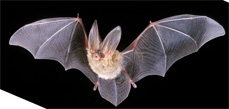 Townsend’s big-eared bats are a species of vespar bats, the largest and best-known family of bats, which belong to the suborder Microchiroptera or microbats. Known by the scientific name Corynorhinus townsendii, the Townsend’s big-eared bat is medium-sized as bats go, weighing from seven to 12 grams. One of their distinguishing traits are extremely long, flexible ears. They also have and small yet noticeable lumps on each side of the snout. They have a total length of roughly four inches, with a tail of two inches. Their widths are nearly three times their length, with a wingspan of about 11 inches.
Townsend’s big-eared bats are a species of vespar bats, the largest and best-known family of bats, which belong to the suborder Microchiroptera or microbats. Known by the scientific name Corynorhinus townsendii, the Townsend’s big-eared bat is medium-sized as bats go, weighing from seven to 12 grams. One of their distinguishing traits are extremely long, flexible ears. They also have and small yet noticeable lumps on each side of the snout. They have a total length of roughly four inches, with a tail of two inches. Their widths are nearly three times their length, with a wingspan of about 11 inches.
Townsend’s big-eared bats proliferate in caves in the Mojave Desert and elsewhere in San Bernardino County. They are also found in other areas of the United States, Canada and Mexico.
This species is found in a variety of locations that range from coniferous forests and woodlands, deciduous riparian woodland, semi-desert and montane shrublands. During the winter months, they hibernate either individually or in groups composed of several hundred bats, and they hibernate in mines or caves. In the summer, these bats roost in a wide variety of locations, including limestone caves, lava tubes, and human-made structures. In the summer, the females form nesting roosts, where they raise their pups.
Males are solitary during the maternity periods. The maternity colonies consist of one or more small clusters, which rarely exceed 100 bats. Females are alert and active in the maternity roosts and prefer dark places for their roosts. These animals are sensitive to light and movement, so if they are disturbed during the day, they awake and their ears begin to move as they try to identify the intruder. If the disturbance occurs for more than a few seconds, the entire group takes flight.
These bats are insectivorous. They emerge late in the day to feed. This species is particularly fond of moths, and is considered a moth specialist, sometimes feeding almost exclusively on Lepidoptera. However, the Townsend’s bat’s diet may include small moths, flies, lacewings, dung beetles, sawflies, and other small insects. This species is a whisper bat, which means that it echolocates at much lower intensities than other bats and may be difficult to record using a bat detector. This may be in part because this species specializes on moths, and some moths have the ability to hear bats and may produce their own noises to ‘jam’ a bat’s echolocation in an effort to thwart predation.
The mating season for the Townsend’s big-eared bat takes place in late fall. As with many other bat species, the female stores sperm in her reproductive tract after mating, and fertilization occurs in the spring. Gestation lasts from 50 to 60 days. As with other bat species, pups are born without the ability to fly. Only one pup is birthed per female.
The average lifespan of a Townsend’s big-eared bat is believed to be 16 years. During the winter, these bats hibernate, often when temperatures are around 32 °F to 53 °F. Hibernation occurs in tightly packed clusters, which could possibly help stabilize body temperatures against the cold. Males often hibernate in warmer places than females and are more easily aroused and active in winter than females. The bats are often interrupted from their sleep because they tend to wake up frequently and move around in the cave or move from one cave entirely to another. Before hibernation, C. townsendii individuals increase their body mass to compensate for the food they do not eat during the winter.
From Wikipedia and the National Park Service’s Website.
SBCSentinel
News of note from around the largest county in the lower 48 states.
